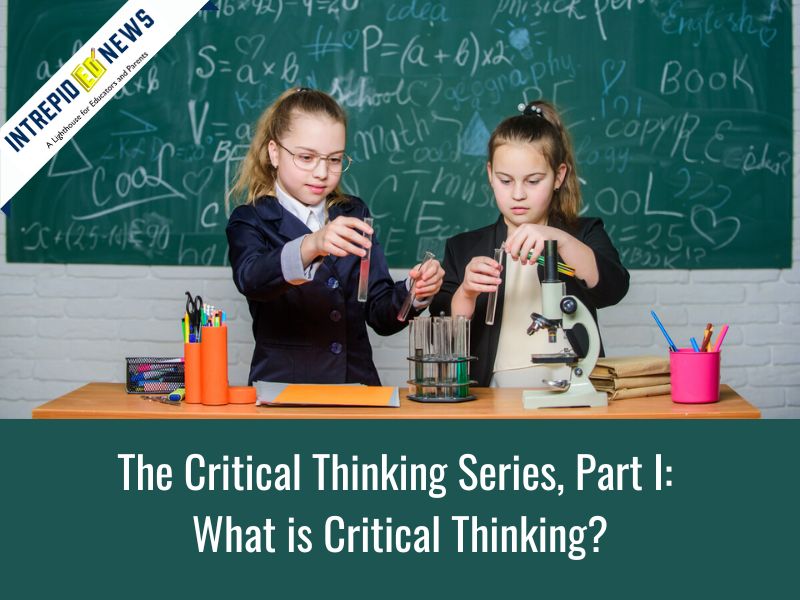The Critical Thinking Series, Part I: What is Critical Thinking?
This article is republished with permission from Intrepid Ed News

– Augusta Moore
It is a common phrase amongst educators that students should be taught how to think and not what to think. Most would agree that one particularly important skill that students should learn in school is the ability to engage in critical thinking. Accordingly, it is important to ask ourselves, as educators, “Am I, in fact, really teaching my students to think critically?” And, if so, “What evidence do I have that my students’ critical thinking skills are actually improving?”
In order to answer either of these questions, it is important to have a clear sense of what critical thinking is. However, when asked to define “critical thinking” many would not be able to provide a very coherent or specific definition of the ability. For example, common explanations of “critical thinking” might include phrases such as clear thinking, reflective thinking, or logical thinking.
But what exactly is clear thinking? What does it mean to be reflective? Is applying rules of logic sufficient for critical thinking? Such phrases, while they do provide bits and pieces of understanding, do not wholly define or explain such an important process. It is important to think more carefully about what we mean by “critical thinking.” How can we effectively teach critical thinking to our students or even share ideas as educators for how to better develop this skill if we all have different understandings of what critical thinking actually is?
John Dewey, in his book How We Think, defines critical or reflective thinking as a series of five steps. Critical thinking is the process by which we identify and then work to solve a problem. It is important to note here that, as defined by Dewey, critical thinking becomes a process inherently centered around a problem. That is, there is no critical thinking without a problem to solve. The five steps are as follows:
- Become aware of a problem
- Define that problem
- Propose various hypotheses as solutions to that problem
- Evaluate the implications of each hypothesis using reason
- Use experience to test the hypotheses
While this definition goes a long way to unify and clarify our concept of critical thinking, we need to go a step further in our definition of critical thinking and provide a standard by which we are said to be engaging in critical thinking well. That is, while many forms of thinking may fit the definition above it also seems to be the case that some instances of critical thinking are better than others.
When considering step 3 as described by Dewey, it is not clear how many hypotheses a student should engage with, how varied they should be, nor what parameters she should consider when identifying and accepting hypotheses as relevant. Often, when educators are talking about critical thinking, the goal is to not simply encourage the student to dust off or revisit old ideas and concepts that she is already familiar with. Rather, to engage in critical thinking well, a student should be able to engage with new ideas, new hypotheses, with which she was previously unfamiliar.
Indeed, someone who engages in high levels of critical thinking (and not simply the basic level that seems to be described by Dewey’s steps) would welcome and seek out hypotheses that might challenge her current perspective on the problem. Moreover, she would most likely consider a wide variety of relevant hypotheses and not just a few relevantly similar solutions to the problem. We want to encourage students to think in such a way because considering a wide variety of hypotheses, including those that engage with new, creative, or unfamiliar concepts, is the most reliable way to ensure that an effective solution is found. Thus, we should augment Step 3 so that it reads: After seeking out and considering a wide variety of hypotheses from multiple sources, propose various hypotheses as solutions to that problem.
Step 5 could also use revision for a similar reason. This final step in the critical thinking process involves using experience to evaluate the hypotheses. But whose experience? Should the student only consider her own experiences when considering which solution to adopt? Or should she be encouraged to seek out the relevant experience of others who may have worthwhile evidence that should be taken into consideration? It seems like, technically, a student could complete Step 5 with only her own experience. However, it might be the case that her experience is limited, not particularly relevant, or biased, which would lead her to come to certain conclusions regarding the hypotheses that would be similarly limited. Importantly, she cannot understand or know how limited her viewpoint is until she opens herself up to the experiences of others. In order to engage in critical thinking well a student must, therefore, be encouraged to seek out the most relevant experiences, even if those experiences are different than or foreign to her own. This requires the student to seek out others, learn about other ways of living, and other kinds of thought, in the process hopefully opening her up to new solutions than she would’ve considered with her experiences alone. Step 5 should therefore be rewritten so it reads: Use experience, one’s own as well as that of others in relevant positions, to test the hypotheses.
There seems to be a clear theme between the expansions of the two steps. In both cases, I have argued, we must expand the steps to include the requirement that students keep an open mind, in other words, that they are open to new solutions or data relevant to their identified problem and that they actively seek those things out. In this way, in order to engage in critical thinking well, a student must be constantly expanding her understanding of potential solutions or the set of data from which she reasons. This is true because it is the only way to ensure that the most effective solution to the problem is reached. Often problems will require novel hypotheses and in order to identify those solutions. Students must keep an open mind.
In Part II of the Critical Thinking Series, we will continue our discussion of critical thinking by considering the role of critical thinking in argumentation and how argument visualization might help encourage good critical thinking. Argument evaluation seems to be an essential component of critical thinking, given our analysis of critical thinking above. That is, we should think of critical thinking as not only involving the production of new hypotheses to new problems but also the evaluation of others’ solutions to proposed problems. Ultimately, we will argue that if argument visualization (through a process call mapping) can help students better understand the structure and organization of arguments that they come across then it will also increase their critical thinking skills.
















Add comment